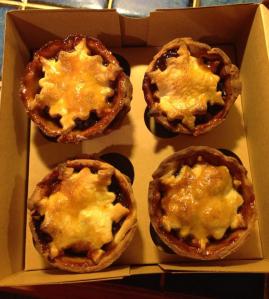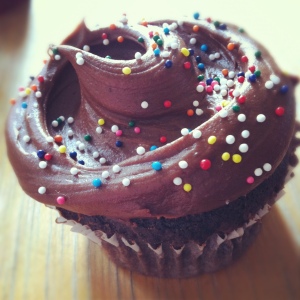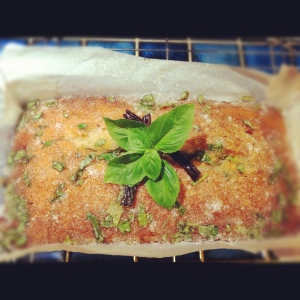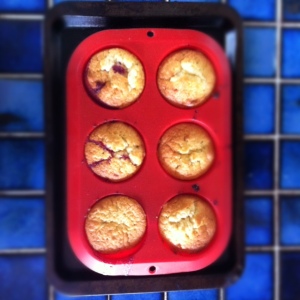I’ve never been a fan of mince pies. The name doesn’t do them any favours. So this year, to overcome my adversity to them, I decided to make them – and now I can’t get enough! I’ve managed to convert a few other mince-pie-haters in the process too! This is a suet-free, nut free mince recipe, but no two mincemeat recipes are the same so feel free to adapt to your taste. If you haven’t got time for the whole process, just pop to the supermarket and supplement with some ready-made pastry and/or mincemeat.
I use this recipe to make a mixture of mini, normal and muffin-tin sized ‘deep filled’ pies so can’t be sure exactly how many you’ll get out of it. It’ll be in the region of 18 deep-filled pies.
Both the pastry and the mincemeat taste best when made a day in advance of making the pies. Keep the mincemeat in a sterilised jar in a cool larder. (The easiest way I find to sterilise is to put the jars into the dishwasher on the highest temperature setting, before starting to cook. Keep the dishwasher door shut until you need the jars. This will keep the jars hot and stop those pesky bacteria getting in!
Ingredients:
For the sweet shortcrust pastry:
250g plain flour
100g icing sugar
150g butter (unsalted)
2 egg yolks
1 egg
Zest of 1 orange
1 tsp grated nutmeg
For the mincemeat:
250g light soft brown sugar
250ml cider
1kg bramley apples
1 tsp mixed spice
1 tsp ground cinnamon
250g currants
250g raisins
100g dried cranberries
75g glace cherries, roughly chopped
Rind and juice of 1 lemon
Rind and juice of 2 satsumas/nectarines or 1 orange
6 tbsp brandy
3 tbsp orange liqueur e.g Cointreau
Method:
For the pastry:
1. It’s really important to keep everything cold when making pastry. Put a grater, a knife, a spoon and any food-mixer bowls/attachments in the fridge 30 minutes before you start. Keeping the pastry cold will keep the gluten strands short and will give you a crisper ‘shorter’ pastry. (The opposite of bread dough which you keep warm, and knead for long gluten strands and a bouncy, chewy dough.)
2. Grate the butter using the chilled grater and return to the fridge. Weigh out the other ingredients. Pass the dry ingredients through a sieve into your cold mixing bowl. Add the chilled grated butter. Work the flour mix and butter with your finger tips to produce a breadcrumb-like texture.
3. Wash your hands and rinse using cold water. Don’t forget your hands are also a cooking utensil when making pastry!
4. Add the eggs. You can use a food processor or kitchen aid for this part but be careful not to work t he dough mixture too much. Otherwise use a cold metal spoon to combine the ingredients and then finally bring together with your hands.
5. Lightly flour the dough, wrap in clingfilm and return to the fridge.
6. Warm your hands up!
For the mincemeat:
1. Peel, core and roughly chop the apples to small dice sized chunks.
2. Dissolve the sugar in the cider in a large pan over a low heat. Add the apples.
3. Add the spices, dried fruit, mixed peel and cherries and stir well. Add the citrus rind and juice and stir again.
4. Keep on a low heat, heat through and simmer for 30 minutes stirring occasionally.
5. Remove from the heat and stir again. Add the brandy and orange liqueur and stir well. Spoon into the sterilised jars and keep somewhere cool until needed.
To make the pies:
1. Remove the pastry from the fridge an hour before needed. Preheat the oven to 220 °C. Grease and lightly flour a tart tin, whether you’re using a mini muffin tin, regular tart tin, or large muffin tin. Tear off about a third of the pastry and keep the rest wrapped in the cling film.
2. Lightly flour your surface and rolling pin. Press the pastry out into a flat circular shape using your hands, then roll out to a thickness of about 3mm. Too thin and the mincemeat might soak through, too think and they will be stodgy and may not cook all the way through.
3. Using a cutter, cut into circles slightly larger than the moulds. Push them into the tart moulds. If there’s any pastry the overlaps the top, you can use a smaller cutter to remove any excess. Re-roll the pastry and repeat until all cases are lined.
4. Roll out more pastry, slightly thicker this time. Use a cutter to cut pastry tops for your pies. I have a snowflake cutter I like to use, but you could use a star, christmas tree or heart shape if you prefer. If you like a shiny finish to your pies, lightly brush each pastry top with an eggwash. Alternatively you can leave them without an eggwash and they will have a rustic, matt finish, equally nice!
4. Fill the pastry cases with the mincemeat.
5. Place the pastry toppers onto each pie making sure they make contact with the pastry liners where possible. (I like to sprinkle mine with a tiny amount of demarara sugar at this stage which makes for a crispy sweet topping.)
6. Place in the oven for 10-15 minutes depending on how large the pies are. Remove once golden and leave to cool in the tin for a few minutes. Once cool enough to handle, remove from the tins and leave to cool on a cooling rack.
7. Box them up and give away as gifts, or sprinkle with some icing sugar before serving, preferably with a dollop of brandy butter and a glass of mulled wine!





















